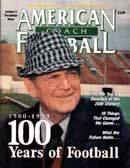AMERICAN FOOTBALL MONTHLY THE #1 RESOURCE FOR FOOTBALL COACHES
Article CategoriesAFM Magazine
|
The Fly-TDivision II Winona State has averaged close to eight yards per play since emphasizing the \'Fly-T\' offense.Offensive Coordinator, Winona (Minn.) State © More from this issue The Fly-T offense is an offshoot of George Halas' T-formation." Its development is attributed to former L.A. Rams offensive coordinator Hamp Pool. From 1950-55, the talented Rams used this offense to lead the NFL in total offense four times and finish a close second the other year. I played in the Fly-T in high school. And I've been using the fly series sparingly for several years - mainly as a distraction to defensive coordinators. Our present head coach and defensive coordinator, Tom Sawyer, assured me that the series "gave the defense fits" in practice. This encouraged offensive line coach Ron Williams and me to keep searching the secrets to its consistency. Winona State was expected to score a lot of points during the 1997 season. We returned nine starters off an offensive unit that set a school scoring record and r....The full article can only be seen by subscribers.
|
|
|||||||
| HOME |
MAGAZINE |
SUBSCRIBE | ONLINE COLUMNISTS | COACHING VIDEOS |
Copyright 2025, AmericanFootballMonthly.com
All Rights Reserved





